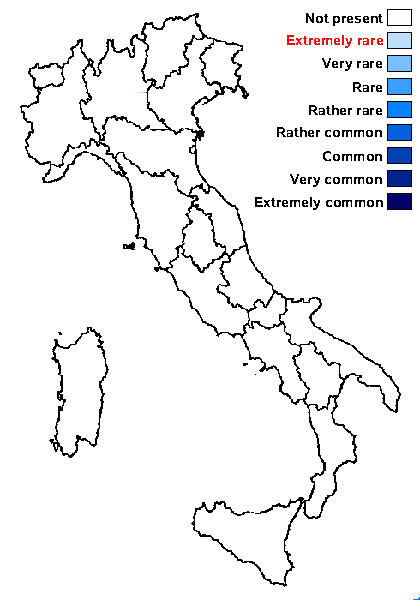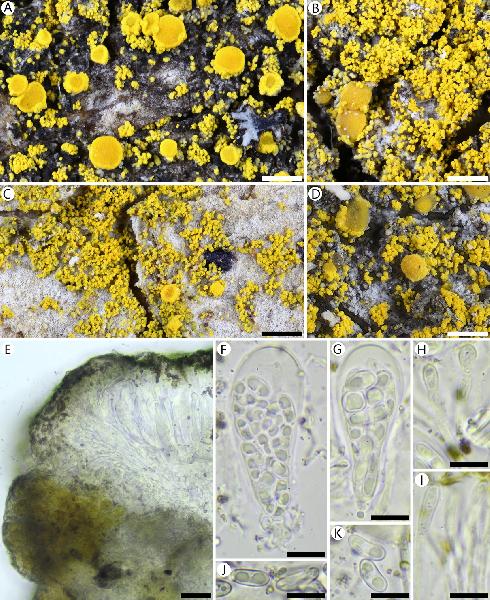Candelariella pulchella van der Kolk, M. Westb. & Malíček
Lichenologist, 57: 153, 2025.
Synonyms:
Distribution:
Description: Thallus crustose, yellow-green to yellow, initially formed by very small, up to 0.15 mm wide areoles which are soon dissolved and obscured by soredia, the soralia not well-delimited as the soredia are initially scattered, gradually becoming confluent and sometimes finally forming a continuous sorediate crusts. Soredia 30-70 μm in diam., yellow, composed of 10-20 photobiont cells irregularly surrounded by hyphae whose outer cells are covered with yellow-brown crystals. Apothecia rare, lecanorine, scattered, 0.2-0.5 mm across, with a flat, yellow-orange disc and a usually paler, irregular, sometimes sorediate, up to 70 μm thick thalline margin; a proper margin is often visible as a smooth, somewhat raised, later sometimes excluded parathecial ring. Thalline exciple with an indistinct pseudocortex, 4-8 um thick; proper exciple up to 60 μm wide in upper part, of radiating hyphae; epithecium to yellow-brown, with small crystals insoluble in K; hymenium colourless, 65-75 μm high; paraphyses simple or sparingly branched, septate, 2-2.5 μm thick, the apical cells cylindrical to clavate, up to 4.5 μm wide. Asci 12-24(-32)-spored, clavate, with an apical dome which is I+ blue only in the internal, lower part, interrupted in the centre by a I+ paler blue strip, Candelaria-type. Ascospores 1-celled, hyaline, narrowly ellipsoid to ellipsoid, straight or slightly curved, with rounded ends, often biguttulate, 10-14 x 4-5 μm, often smaller in asci with many ascospores. Photobiont chlorococcoid. Spot tests: K-, C-, KC-, P-. Chemistry: pulvinic acid derivatives. Note: a recently-described species, so far known from several localities in temperate to boreal Europe, growing on the bark of deciduous solitary or roadside trees (e.g. Acer, Fraxinus, Populus), more rarely on nutrient-enriched wood. To be loked for in Italy. For further details see van der Kolk & al. (2025).
Growth form: Crustose
Substrata: bark
Photobiont: green algae other than Trentepohlia
Reproductive strategy: mainly asexual, by soredia, or soredia-like structures (e.g. blastidia)

Predictive model

source: van der Kolk H-J, Westberg M, Malíček J. Morphological and molecular data support the distinction of four sorediate corticolous Candelariella species in Europe. The Lichenologist. 2025;57(3-4):144-165. doi:10.1017/S0024282925101059 - CC BY 4.0
Candelariella pulchella sp. nov. A, E–K, holotype. B, Malíček 9130. C, Malíček 11867. D, M. Westberg s. n. (UPS L-1027546). E, apothecial margin. F & G, multispored asci. H & I, paraphyses tips. J & K, ascospores. Scales: A–D = 0.5 mm; E = 20 μm; F–K = 10 μm.
Growth form: Crustose
Substrata: bark
Photobiont: green algae other than Trentepohlia
Reproductive strategy: mainly asexual, by soredia, or soredia-like structures (e.g. blastidia)

Predictive model


